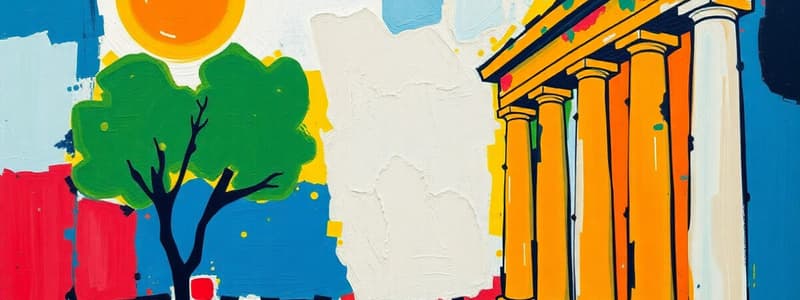Podcast
Questions and Answers
What art form were Romans especially skilled at painting?
What art form were Romans especially skilled at painting?
- Frescoes (correct)
- Cameos
- Mosaics
- Sculptures
Roman artists did not influence modern art.
Roman artists did not influence modern art.
False (B)
During which period was Roman art rediscovered?
During which period was Roman art rediscovered?
Renaissance
The famous ceiling of the Sistine Chapel was painted by ________.
The famous ceiling of the Sistine Chapel was painted by ________.
Match the following Roman art forms with their descriptions:
Match the following Roman art forms with their descriptions:
Which feature of Greco-Roman art is primarily seen in Roman sculptures?
Which feature of Greco-Roman art is primarily seen in Roman sculptures?
Wealthy Roman families often sponsored art by decorating their homes with it.
Wealthy Roman families often sponsored art by decorating their homes with it.
What decorative object did Romans create that was shaped like clusters of grapes?
What decorative object did Romans create that was shaped like clusters of grapes?
The term used to describe the blending of Greek and Roman art is ________ art.
The term used to describe the blending of Greek and Roman art is ________ art.
What city do tourists flock to in order to see art influenced by Roman styles?
What city do tourists flock to in order to see art influenced by Roman styles?
Flashcards are hidden until you start studying
Study Notes
The Legacy of Roman Art
- Romans blended aspects of other cultures, particularly Greek, to form their own unique artistic style.
- Historians frequently refer to this combined style as "Greco-Roman" art.
- Rome played a pivotal role in preserving this style, greatly influencing Western art.
- Roman artistic talents included:
- Skillful imitation of Greek sculptures, notably lifelike busts and statues.
- Extravagant patronage of art, with wealthy families adorning homes with statues, murals, and mosaics.
- Mastery in fresco painting, utilizing water-based paints on moist plaster to create scenes resembling three-dimensional landscapes.
- Application of artistic style and luxury to everyday items, like decorative blown-glass bottles.
- Development of gem-cutting and metalworking techniques.
- Popularization of cameos, carved decorations adorning jewelry, vases, and other objects.
- Roman art experienced a revival during the Renaissance period around a millennium after the empire's fall.
- Renaissance artists, such as Michelangelo, revived the Greco-Roman style in their paintings and sculptures.
- The Sistine Chapel ceiling, painted by Michelangelo in the 16th century, features scenes from the Bible and exemplifies the enduring influence of Roman art.
- Roman art styles have continued to inspire artists over the centuries.
- American artists, particularly in the early United States, frequently adopted Roman styles to imbue their art with dignity and nobility.
- Numerous statues in Washington, D.C., reflect a strong Roman influence.
Studying That Suits You
Use AI to generate personalized quizzes and flashcards to suit your learning preferences.




